Jamie Carstairs, who manages the Historical Photographs of China Project, reports on the tribute to the photographer John Thomson FRGS, whose grave has now been restored.
John Thomson (1837-1921) is acclaimed in Martin Parr and Gerry Badger’s The Photobook: A History as ‘one of the best [foreign] photographers ever to set foot in China’. Over a ten-year period (1862 to 1872), Thomson photographed in China, Cambodia, Thailand and Malaysia. Thomson had trained in Edinburgh as an optician, and then applied his knowledge of optics and cameras, with chemistry/photographic processes. Mashing science with art, Thomson’s skill set included a grasp of the aesthetics of visualisation, linguistic, and ‘people’ skills. He had an engaging personality, which fostered quick rapport and trust to be established. In many ways, Thomson is the photographer’s photographer. He also wrote in a droll and perceptive way. Martin Parr and Gerry Badger’s accolade is all the more of note, considering briefer visits to China by photographers such as Henri Cartier-Bresson and Robert Capa for example.
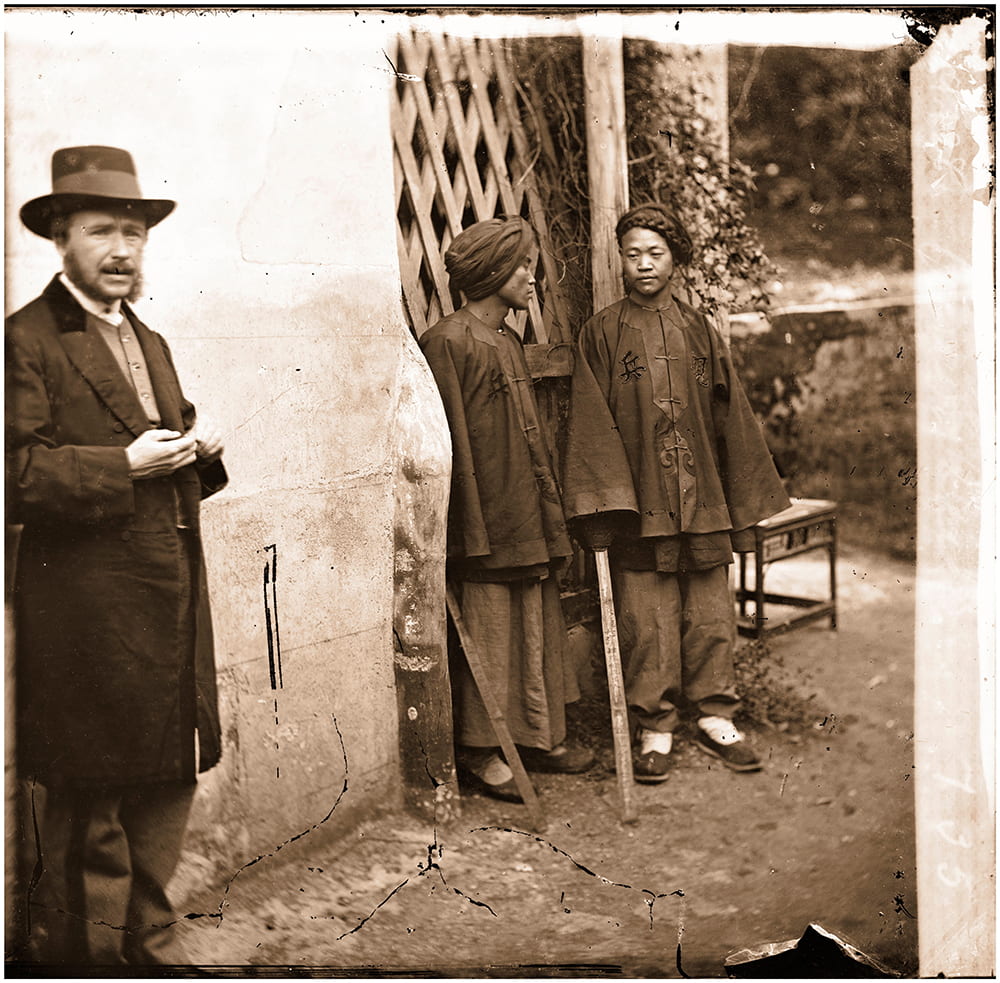
John Thomson, with two soldiers, in Xiamen (Amoy), 1871. Is this the earliest selfie in China? Thomson looks towards his camera, somewhat anxiously, during the exposure. It seems likely that Thomson would have intended to crop off the left-hand side of this image, when the negative was printed or published. A scan of a glass plate negative, numbered 735 by Thomson, held by the Wellcome Collection.
The restoration and re-installation of John Thomson’s grave was completed by the stonemasons just in time for a commemorative event in Streatham Cemetery, south London, on Saturday 13 July. Betty Yao MBE led the John Thomson grave restoration committee*, as well as setting up the JustGiving crowd funding appeal and also liaising with the local council and stonemasons. The gathering was attended by 25 people – including three of Thomson’s descendants, some of the donors who had kindly contributed to the cost of the work, photo-historians, local historians, photographers, and representatives from the Wellcome Collection and Friends of Streatham Cemetery. Betty Yao introduced the speakers.
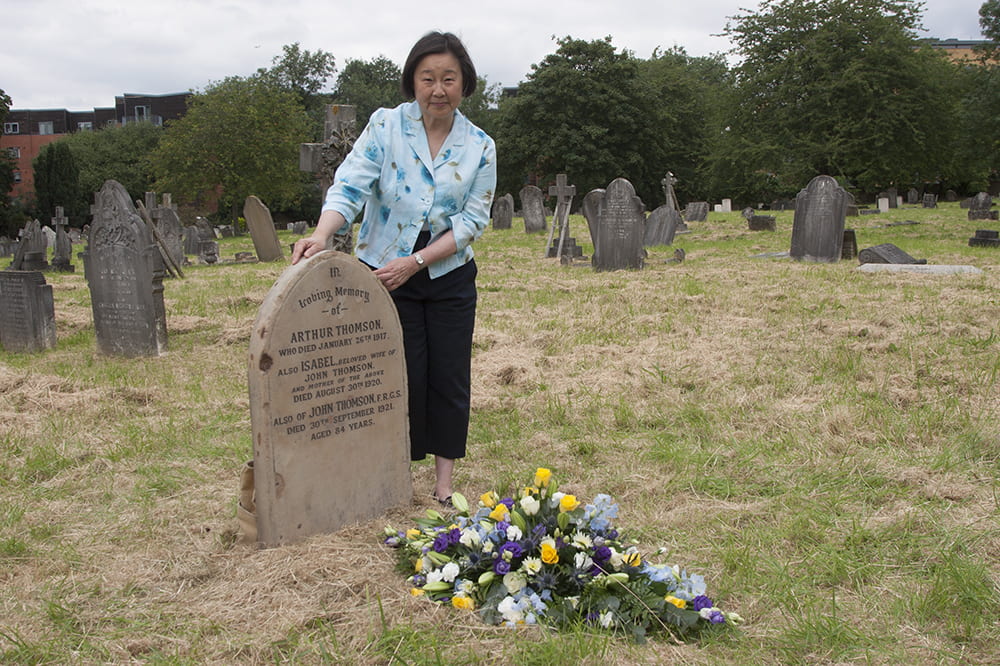
Betty Yao MBE beside John Thomson’s restored grave, Streatham Cemetery, Tooting, London, 13 July 2019. Photograph by Jamie Carstairs.
Terry Bennett gave an informative and moving appreciation, in which he described Thomson as a ‘prodigious talent’ and a ‘master of his art’, reaching this conclusion for four reasons: 1. Thomson was a prolific writer. 2. He was adept at marketing his work in numerous publications. 3. A significant number of his glass plate negatives have survived. 4. Photo-historians have now identified a sufficient body of work by other early photographers to enable comparisons to be made.
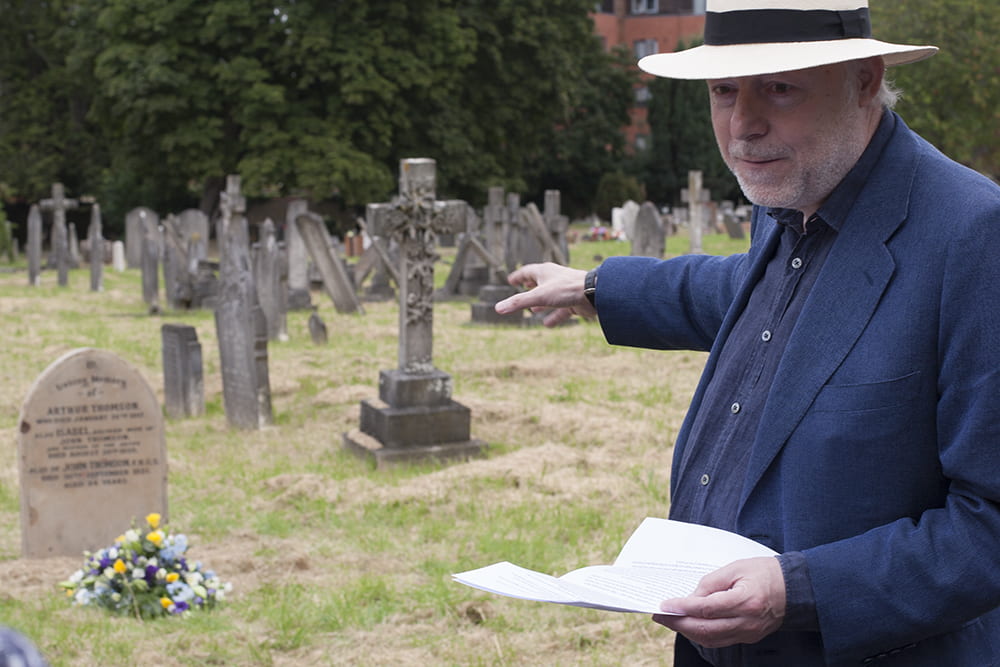
Terry Bennett describing how he found the site of John Thomson’s grave in Streatham Cemetery. Photograph by Jamie Carstairs.
Terry told how he had tracked down Thomson’s lost grave, starting with his death certificate, which stated that he had died of a heart attack on a tram in Streatham Hill. Thomson’s Will and probate records gave his last address, which was in Streatham. The Streatham Historical Society kindly provided Terry with the addresses of four likely local cemeteries and one of them provided the burial block plot reference. Finding the exact spot was still not easy. Terry was helped by cemetery workers, who also provided a brush and a bucket of water to remove dirt which had accumulated over the fallen gravestone. Found at last – but the neglected state of the modest headstone suggested that the forgotten grave had not been visited for many years – “a sad sight”.
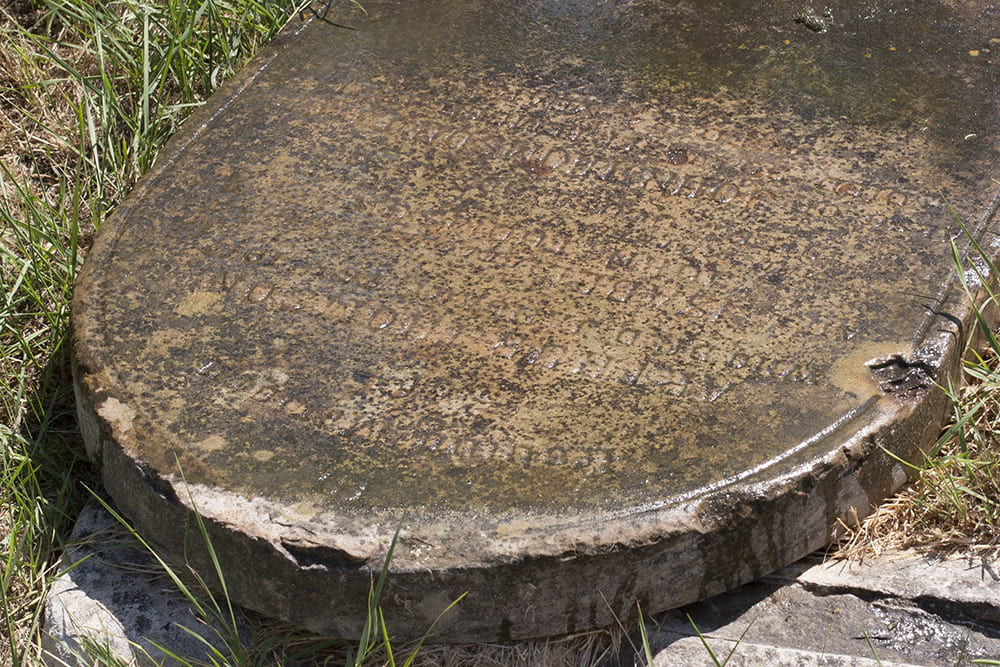
John Thomson’s headstone in August 2018, before restoration. Photograph by Jamie Carstairs.
Michael Pritchard, CEO of Royal Photographic Society, read a message from Rose Teanby. Rose had helpfully shared with Betty her experience of restoring the grave of Robert Howlett. This endeavour was also “fraught with complexity, delicate negotiations and wrapped up in few miles of red tape!” (Howlett being famous for his portrait of I.K. Brunel, posed with the massive launching chains of the ss Great Eastern). Another helpful exemplar was the restoration of Sir Robert Hart’s grave in 2013, led by historians Robert Bickers and Weipin Tsai. A little blue bird tells me that the grave of George Ernest “Morrison of Peking”, in Sidmouth, Devon, is in need of similar TLC, a project for someone …
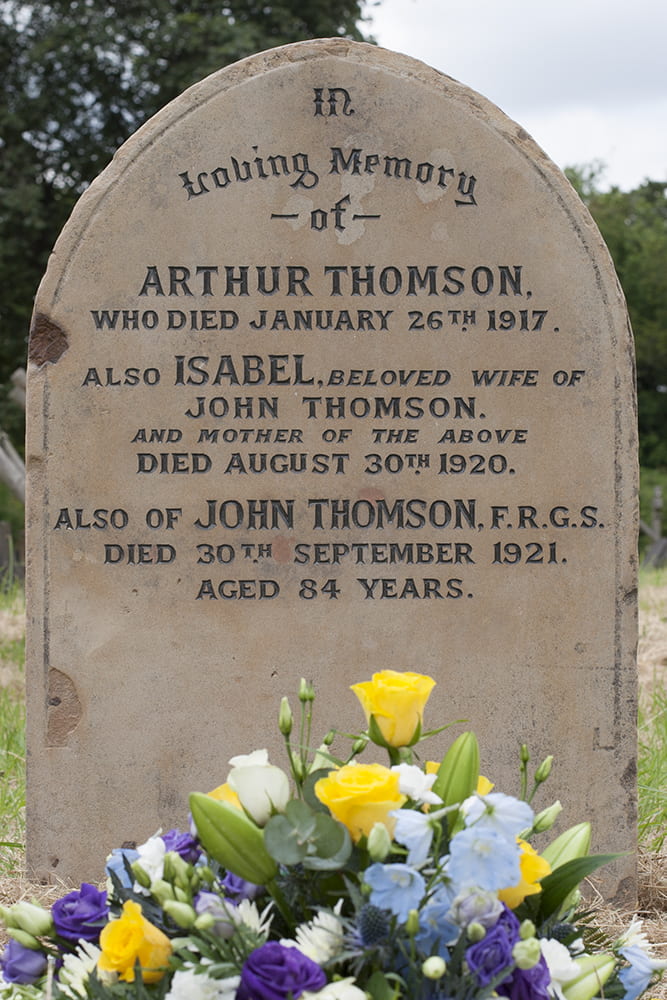
The restored gravestone for John Thomson, his wife Isabel and their son Arthur. Streatham Cemetery, Tooting, London. Photograph by Jamie Carstairs.
Caroline Thomas also spoke of her celebrated forebear. Betty Yao noted that, ‘It is fitting that we restore his grave as a renewed memorial to the man and his work’.
The restoration work by Vaughan Memorials was much admired: the rough face of the eroded headstone had been smoothed and the lettering recut and blacked in. Doris Florist made a beautiful bouquet and other flowers were added by attendees. It had taken over a year to, as Terry Bennett said, ‘effect some modest restoration and contribute a sense of respect and dignity to the final resting place of one of the greatest photographers in the nineteenth century’.
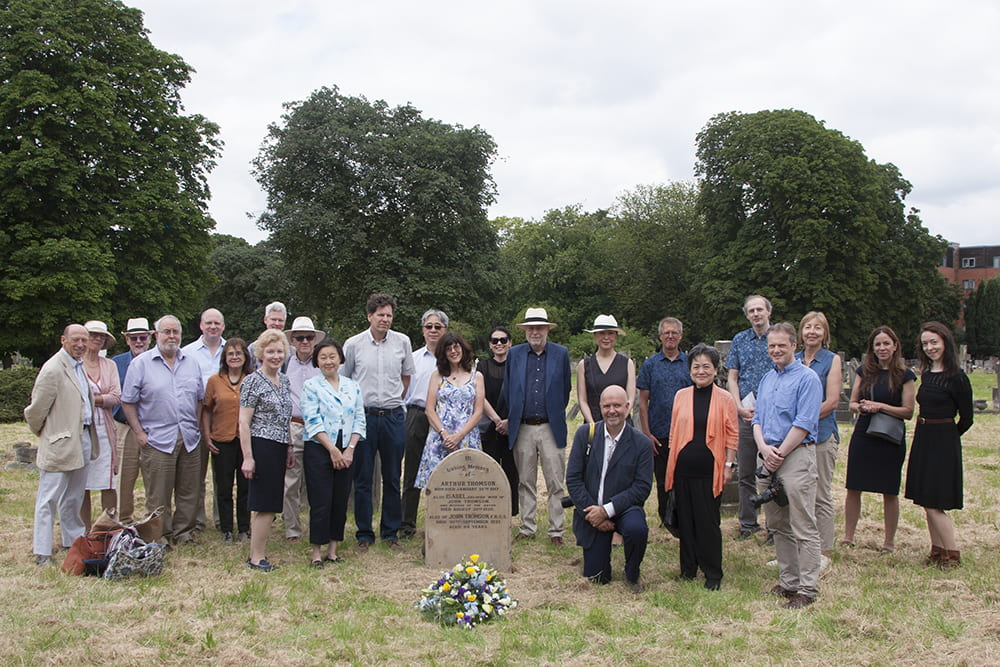
Attendees at the John Thomson commemorative event, at Streatham Cemetery, 13 July 2019. Photograph by Jamie Carstairs.
The ‘stellar efforts’ of Betty Yao are appreciated by ‘fans’ of John Thomson worldwide. The grave restoration committee* was pleased to have achieved our goal in good time for Thomson’s centenary. In 2021, the 100th anniversary of Thomson’s death, it is hoped that Betty Yao’s exhibition of Thomson’s photographs of China and Thailand, will be on show again – perhaps in Edinburgh, the city of his birth? The very large prints, made from the Wellcome Collection’s excellent scans of Thomson’s negatives, are a joy to behold.
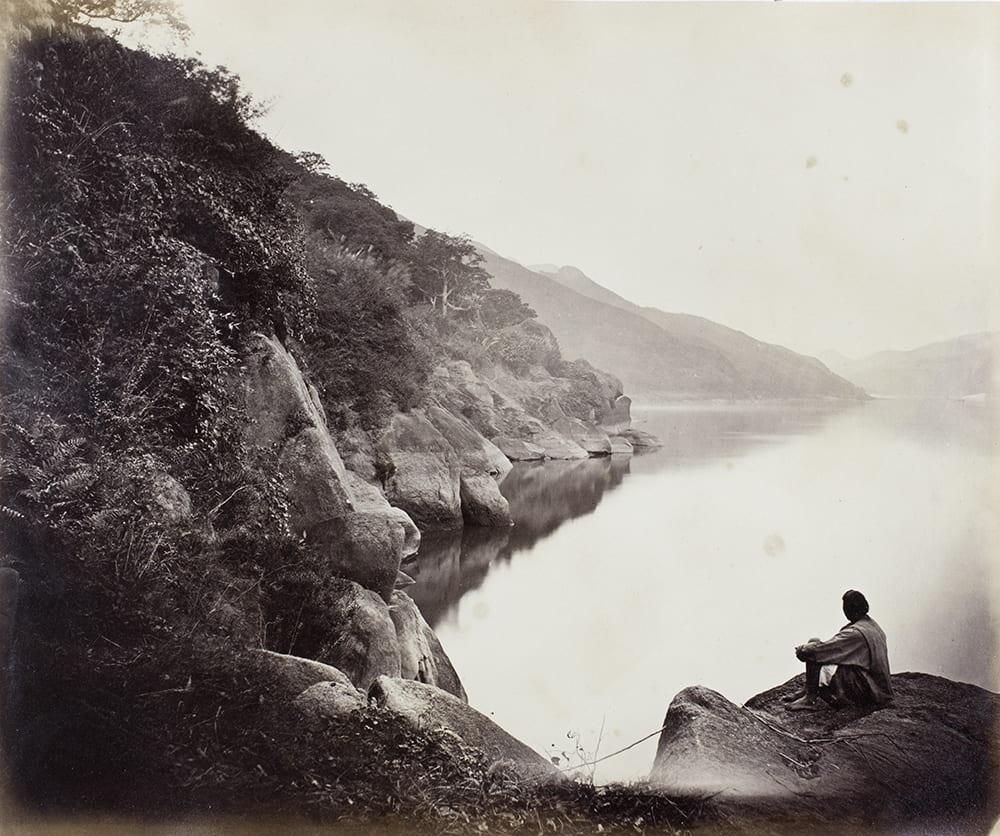
Photograph by John Thomson, c.1870. Captioned: “View 50 miles above Foochow. Sunset on the Min”. John Fry Collection (Fr01-096).
* The John Thomson grave restoration committee: Betty Yao MBE, Terry Bennett, Michael Pritchard, Deborah Ireland, Geoff Harris, Jamie Carstairs.
Visualising China (31 May 2018): Restoring John Thomson’s grave
British Photographic History (13 July 2019): John Thomson’s grave restored
The Scotsman (20 July 2019): The grave of a pioneering Scottish photographer who took some of the earliest pictures of China on record has been rediscovered and restored in London
